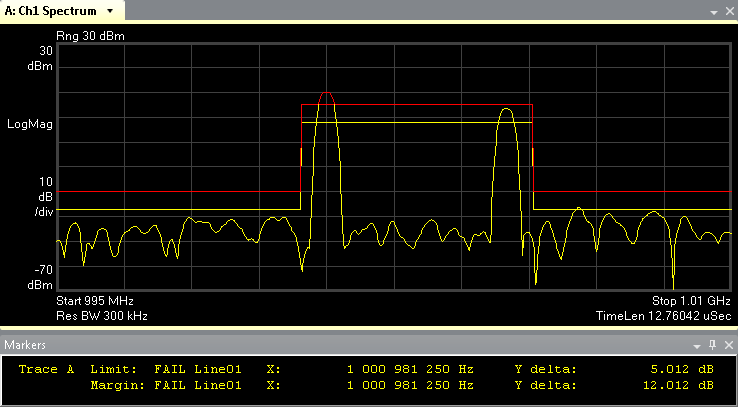About Limit Tests (Limit Tests)
Limit lines can be created to compare trace data to your defined limits and indicate a pass or fail condition. Limit lines are organized in a hierarchy where a Limit Test is a collection of Limit Lines and a Limit Line is a collection of Limit Points.
The limit test is the object applied to the trace data. Limit tests can only be applied to frequency or time-domain data. Each limit test has a unique name that can be user specified for test identification, saving and recalling tests. (The default name is set to TestX where X is a unique number starting with 1. The default name of the first test created will be Test1.) A user-specified name can better identify the test for future reference. The limit tests are listed in the Limit Tests Dialog Box.
A limit test can be either user defined or generated from recalled data containing limit lines. (If trace data with limit lines is recalled, the limit test can be recreated for editing and applying to new data. See From Trace for more information.) The information in a limit test can be created, edited, deleted, saved and recalled. A limit test must be selected from the Limits Tab in the Markers dialog to be displayed on a trace.
A limit test can contain multiple limit lines. Each limit line has a unique name for identification and editing. The limit lines are listed by name in the Limit Test Editor Dialog Box for a specific Limit Test. Also, when a limit line or margin line is turned on, the name of each limit line and margin line is displayed in the marker results area at the bottom of the screen, along with its pass/fail status and information. The default name is set to LineX where X is a unique number starting with 1. The default name of the first line will be Line1. PASS or FAIL also is displayed in the status bar. (PASS if all limit lines pass and FAIL if any limit lines fail.) The default color for a limit line is red and for a margin line is yellow. The limit and margin line properties are set in the Line Tab of the Limit Line Editor. The units and references for the limit and margin lines are set in the Units Tab of the Limit Line Editor.
A limit line is a collection of limit points. These points are defined points which are connected into line segments that are applied to the trace data. The points are defined by specifying a X-axis value, a Y-axis value for each point and whether the point is connected to the previous point or not. The limit points are listed in ascending X-axis value order in the Points Tab of the Limit Line Editor.
The following is an example of a limit line (red) with a 7 dB offset margin line (yellow). The marker readout area shows information about both the limit and margin lines including the status (Pass or Fail) and the frequency location and distance from the limit/margin lines for the furthest point in the trace. The furthest point depends on whether the limit line's Side parameter is set to (furthest = highest point in trace) or (furthest = lowest point in trace).

See Also
